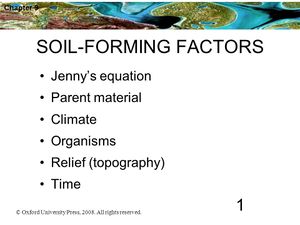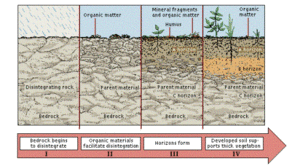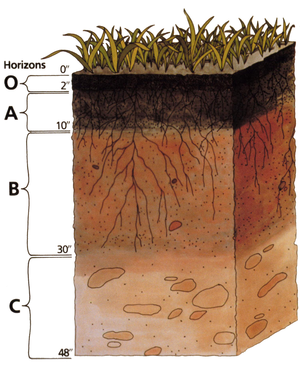Jenny Equation: Difference between revisions
| Line 58: | Line 58: | ||
http://forces.si.edu/soils/02_01_04.html | http://forces.si.edu/soils/02_01_04.html | ||
https://www.revolvy.com/main/index.php?s=Clorpt | |||
Revision as of 13:15, 9 March 2018
Origins
The Jenny Equation was created by Hans Jenny in the early 1940’s. It was first inter-nationally recognized when Hans Jenny published his book “Factors of Soil Formation” in 1941. The jenny equation is a formula used to help determine the properties of the soil, whether it will be fertile or not, what kind of minerals it contains, as well as the organisms living with in the soil and the chemical reactions that will occur in the soil around plant roots and the other organisms.
Hans Jenny
Hans Jenny was born in Switzerland in 1899, he attended multiple universities through his life and received a great education. His college career started with the Swiss Federal Institute of Technology (Zurich) where he received a bachelor in agriculture in 1922. He later received degrees in chemistry and ion exchange reactions by 1927, also from Zurich. His intensive education helped him formulate the Jenny Equation, which is S = f(cl, o, r, p, t, …). In this equation the “S” represents soil formation, cl is climate, o is organisms in the soil, r is relief such as the topography, “p” is the parent material, “t” is the time that takes place. He left the “…” in case something new was discovered or needed to be added later.
Uses of Jenny Equation
The Jenny Equation helps determine the physical properties of soil based on several independent factors. These factors known as the pedogenic processes which in this equation are; climate, organisms, topography, parent material, time and any other factors that may apply.

Climate

The climate has a big effect on the soils, rainfall has the impact of weathering and erosion. This helps to break down the larger rocks and other soil particles into smaller pieces. Two of the most influential factors of climate are temperature and moisture. Temperature has a direct effect on the rate that chemical reactions can occur in the soil. The higher the temperature the quicker the reactions will happen with in the soil. Moisture also affects the rates of chemical reactions that can happen in the soil. The higher the moisture levels the higher the rate of chemical reactions will occur. This will allow plants to grow faster, as well as allowing the bacteria and fungus to be more active. This includes the decomposers to decompose dead organisms much faster when the temperature and moisture levels are high.
Organisms
The organisms in the soil also influence the soils processes and functions. The vegetation and animals are a big part of this. Plants roots help to break up the soil creating more surface area for water to seep into. This allows chemical reactions to occur here as plants excrete chemicals that help these chemical reactions to take place. These chemicals, released by the plants, also attract bacteria and fungi. This allows them to help speed up the roots ability to uptake nutrients as well as fend off harmful chemicals and organisms. Bacteria and fungi also can multiply and break down dead organisms more easily. The animals that have died and are in the soil allow for more nutrients to be available for the plants to uptake. This can only happen after the animals are decomposed, which also makes the soil more fertile.
Topography

The next factor that is in the equation is topography. Topography is the slope of the land, whether there is a hill or a valley or a flat plain. The topography of the land has a big effect on the moisture content of the soil. For example, a hill will have a lower moisture content because of the increased runoff. A valley will have a very high moisture content because the amount of water that can go into the soil is higher as the water will puddle up and have more time to infiltrate. A plain will have a medium amount of moisture in the soil. The slope also effects the type of vegetation that can grow as there will be more moisture in some areas than others.
Parent Material
The parent material of the soil is determined from what type of rock it is derived from. Igneous, metamorphic, or sedimentary rock break down and create different types of soil, whether it is sandy, silt or clay dominated soil. The breaking down of the soil increases the surface area which allows more reactions to happen, the soil can hold more water, and more organisms can live within it. The parent material will also determine what kind of minerals make up the soil. For example, if some rock rich in phosphorous, breaks down due to weathering, the soil that it creates will have a higher content of phosphorus. The minerals in the soil, will affect the types of organisms and plants that can thrive in the soil. In a soil is darker colored it is from a volcanic eruption these are metamorphic rocks, and lighter soils are formed from igneous rocks.
Time
Time is the next variable in the equation, the amount of time directly effects the weathering rates. As the time increases the more weathering can occur, this allows the parent material to break down further and create different minerals and smaller soil particles. Time also effects the amount of growth a plant will have. And interact with the soil, through roots and the chemicals released by them, as well as the uptake of nutrients.
Additional Factors
Hans Jenny also left room in the equation for any other factor that he could not think of, or has yet to be discovered. However, nothing since has been added to Hans Jenny’s equation since it was wrote in 1941. As no new factors have been discovered that influence the way soils react with its environment.
References
http://www.physicalgeography.net/fundamentals/10u.html
http://www.innspub.net/wp-content/uploads/2013/12/JBES-Vol3No12-p125-134.pdf
https://www.researchgate.net/publication/280237646_Predicting_soil_map_using_Jenny_equation